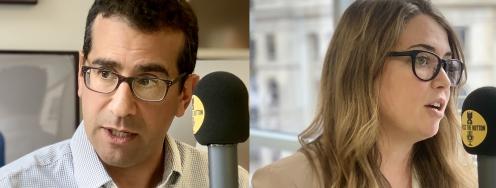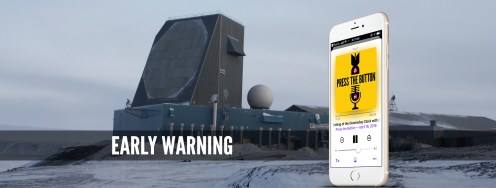Avoiding a Nuclear Bailout for the Navy
On the radar: Reduce requirements before fattening budgets; Enrichment positioning; New START data update; Congress still likes sanctions; Tailored deterrence on the peninsula; Netanyahu’s speech; and Harold Agnew, 1921-2013.
On the radar: Reduce requirements before fattening budgets; Enrichment positioning; New START data update; Congress still likes sanctions; Tailored deterrence on the peninsula; Netanyahu’s speech; and Harold Agnew, 1921-2013.
October 2, 2013 | Edited by Benjamin Loehrke
Navy nuclear bailout - Buying a $100 billion fleet of ballistic missile submarines could sink the Navy’s shipbuilding budget and force the Navy to cut boats for its surface fleet. Hoping to avoid that, the Navy recently asked Congress for an extra $4 billion each year - $60 billion total - while subs are under construction.
--”The Navy needs relief from its nuclear burden — but not in the form of an annual $4 billion bailout. Instead, the Pentagon needs to better integrate its plans for a smaller nuclear force with the Navy plans for its future battle force. Buying fewer subs would save billions of dollars, allow the Navy to modernize its surface fleet and avoid overinvesting in weapons that have — by explicit national policy — a diminishing role in U.S. national security strategy,” writes your humble Early Warning editor for Roll Call. http://bit.ly/1c4Hu1i
Positioning for a deal - Western governments are considering allowing Iran to continue some uranium enrichment, as part of a possible deal...The new stance - a reaction to President Hassan Rouhani's overtures to the West - would mean easing a long-standing demand that Iran suspend all enrichment, due to concerns Tehran could be developing nuclear weapons,” report Justyna Pawlak and Luke Baker for Reuters. http://reut.rs/GzDzwg
Welcome to Early Warning - Subscribe to our morning email or follow us on twitter.
--Have a tip or feedback for the editor? Email earlywarning@ploughshares.org earlywarning@ploughshares.org. Want to support this work? Click here.
New START Data - As of September 1, under data for the New START treaty, the U.S. had 1688 nuclear warheads deployed on 809 out of a total 1015 strategic delivery vehicles. Russia had 1400 nuclear warheads deployed on 473 out of a total 894 strategic delivery vehicles. The State Dept. provides the aggregate numbers. http://1.usa.gov/18OCxGL
--These numbers represent slight reductions or adjustments since the previous data exchange in March. http://1.usa.gov/XfMk3t
Sanctions outlook - Despite the thaw in US-Iran relations and outlook for a negotiated solution, many in Congress appear eager to heap new sanctions on Iran. AP reports on the motions within Congress to pass a new sanctions bill. Though, due to the congressional calendar, no such bill is expected to be finalized until November - allowing space for initial nuclear negotiations with Iran. Full story here. http://n.pr/1aL3Lxe
Tailoring - Sec. Chuck Hagel and his South Korean counterpart, Kim Kwan-jin, signed a new defense pact that features a “bilateral strategy for tailored deterrence against the threat of North Korean nuclear weapons and other weapons of mass destruction.”
--”The ministers did not give any immediate indication of what the ‘tailored deterrence’ strategy might entail despite questions from the media.” write David Alexander and Jack Kim for Reuters. http://reut.rs/16YFkbR
NYT on Bibi’s speech - “It could be disastrous if Mr. Netanyahu and his supporters in Congress were so blinded by distrust of Iran that they exaggerate the threat, block President Obama from taking advantage of new diplomatic openings and sabotage the best chance to establish a new relationship,” writes The New York Times in an editorial on the Israeli Prime Minister’s UN speech yesterday. Full article here. http://nyti.ms/18P4CvM
Iran readings:
--”Pushing Peace: How Israel Can Help the United States Strike a Deal With Iran -- And Why It Should” by Trita Parsi in Foreign Affairs. http://fam.ag/GzNMIM
--”Iran Opens Its Fist” by Gary Sick in The New York Review of Book. http://bit.ly/19hxSPy
Hardol Agnew - “Harold M. Agnew, the last surviving major figure to have been present at the birth of the nuclear age — who helped build the world’s first reactor and atomic bombs, flew on the first atomic strike against Japan, filmed the mushroom cloud, helped perfect the hydrogen bomb and led the Los Alamos National Laboratory at the height of the cold war — died Sunday at his home in Solana Beach, Calif. He was 92.” Obituary by William Broad of The New York Times. http://nyti.ms/16Gu76p
Events:
--”Reversing Iran’s Nuclear Program” Hearing of the Senate Foreign Relations Committee with Testimony from Under Secretary of State Wendy Sherman. October 3rd at 10am in Dirksen 419. Details and webcast. http://1.usa.gov/18FVpYx
--"Russian Foreign Policy in the 21st Century." Former Russian Foreign Minister Igor Ivanov speaks at Georgetown. October 3 at 6:00pm. Details and RSVP. http://bit.ly/19iqOwd
--"Preventing Nuclear War in South Asia: Unprecendented Challenges, Unprecedented Solutions" Discussion with George Perkovich. October 3rd at 6:00pm in Harvard’s NYE Conference Center. Details here. http://hvrd.me/19QnKs5
--”Getting to Yes With Iran” Discussion with George Perkovich. October 4th from 9:30-11:00am at Harvard’s Belfer Center Library. Details here. http://hvrd.me/14XROUt
--50th anniversary of JFK signing the Limited Test Ban Treaty. October 7th. http://bit.ly/18FCzPa
--”Rethinking U.S. Nuclear Weapons Policy” Discussion with Benjamin Friedman, Christopher Preble and Laura Odato of CATO Institute. Oct. 8th at noon in the Rayburn House Office Building. RSVP here. http://bit.ly/1dS3evw


